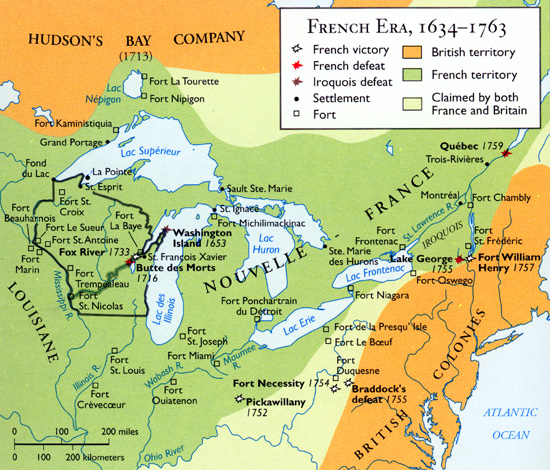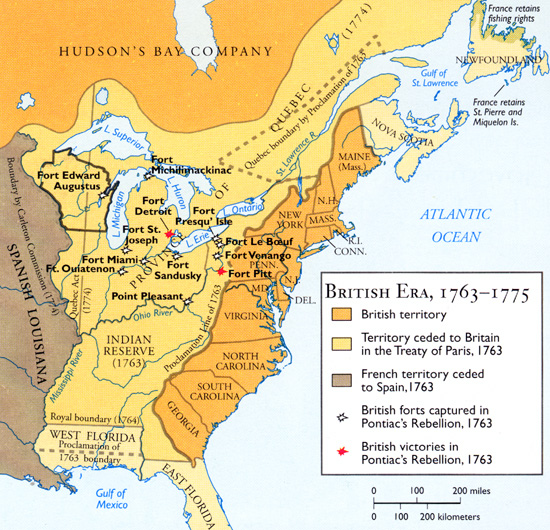The French and Indian War was part of the Seven Years War waged between France and England. They fought for control of North America and the rich fur trade.
Background
The French, who had a strong presence in the Great Lakes region early on, built a fort at Green Bay in 1717 to tighten their hold on the western Great Lakes. They became embroiled in a series of wars with the Meskwaki (Fox) Nation. The conflicts disrupted fur-trade routes along the critical Fox-Wisconsin waterway to the Mississippi. The French also developed a new route along the Maumee, Wabash, and Ohio rivers to bypass the western lakes. This new trade route brought the French into sharper conflict with the British, whose colonists were seeking to claim the same areas. The British and French vied for control by courting local Native nations, but neither side was able to secure the region. The establishment of a series of French forts in the area prompted the colonists to take action. In 1754 Colonel George Washington led a Virginia militia force to demand removal of the forts, but had to retreat after a brief skirmish, the first in a series of encounters that led to war (the French and Indian War) the following year.
Details
The rich lands which lay between and to the west of the French settlements of Canada and
the British colonies along the East Coast of North America were inevitably destined to
become a battleground between the forces of these two European rivals. From 1754 to 1763,
the British and French fought for this wilderness of huge potential in a conflict which,
though part of the wider Seven Years War, has come to be known as the French & Indian
War. The French and Indian War was fought to decide if Britain or France would be the
strong power in North America. France and its colonists and Indian allies fought against
Britain, its colonists and Indian allies. The war began with conflicts about land.
French explorers had been the first Europeans in the areas around the Great Lakes and the
Ohio and Mississippi rivers. France had sent traders and trappers to these territories and
had established trading centers there. Britain claimed the same land. When the king
gave land in North America to someone, the land was considered to extend from the East
Coast to the West Coast, even though no one knew where the west coast was. The land along
the east coast had become crowded, and settlers were moving west. White people were
destroying the Indians' hunting areas. The Indians became worried that they would lose the
use of their land. The Indian tribes may have been able to resist the people moving
west if they had been united. But their own conflicts kept the Indian groups apart. When
Britain and France started fighting each other, some Indians helped the British. Others
helped the French.
The French settlers lived mainly in what was called New (Nouvelle) France. Today it is
part of Canada. The French had many successes early in the war. Strong leadership
within the military, the size of the French army, and the number of Indians who allied
themselves to the French made it difficult for the British. In 1757, a new English
prime minister, William Pitt, vowed to win the war against the French. In 1758, there were
better trained British generals and more prepared armies fighting the French in North
America. The British started to win battles. Also, Indians who had allied themselves to
the French began to ally themselves to the British. In 1758, the British captured Fort
Duquense and renamed it Fort Pitt. This was an important victory for the British and
helped to raise the troops morale. The British were now able to focus on the French
forts in Canada. The British took control of Fort Niagara, an important outpost for the
French. From there, the British captured Quebec. After the British captured Quebec, the
French were never able to recover. By 1760, the British controlled Montreal also. Once the
British took Montreal, the fighting in North America was over. However, the Seven
Years War continued in Europe and India and the Treaty of Paris was not signed until 1763.
When the treaty was signed, the British were given control over the area west of the 13
colonies to the Mississippi River.

Source: Atlas of Wisconsin
Life in Nouvelle France was different from life in the British colonies to the south.
There was no religious freedom, for example. All settlers in French territories had to be
French and belong to the Roman Catholic Church. So, many French people who belonged to
Protestant churches settled in the British colonies. France also did not like the fact
that the British paid the Indians high prices for animal furs. France was more interested
in the fur trade than in settling the land. The British hurt the French traders' business
when they bought fur from the Indians.
French colonies in North America, isolated from France by British
domination of the seas, were left mostly to their own meager resources to carry out the
French and Indian War. Wisconsin native tribes--including the Menominee, Ho-Chunk, Ojibwe,
and Potawatomi--participated in military campaigns led by French army officer Charles de
Langlade. However, by 1760 the French had lost Quebec and Montreal to the British.
The French and Indian War ended after the British defeated the French
in Quebec. In 1760 the British took over Fort Pontchartrain (at Detroit) and renamed it
Fort Detroit, effectively ending the war. However, the war "officially"
ended in 1763 (when Britain and France signed the Treaty of Paris) in 1763. The British
had won the French and Indian War. They took control of the lands that had been claimed by
France (see below). France lost its mainland possessions to North America. Britain now
claimed all the land from the east coast of North America to the Mississippi River.
Everything west of that river belonged to Spain. France gave all its western lands to
Spain to keep the British out. Indians still controlled most of the western lands, except
for some Spanish colonies in Texas and New Mexico.

Source: Atlas of Wisconsin
The Treaty of Paris was the treaty that ended the French and Indian War . Although the fighting in North America had concluded in 1760, the Seven Years War was still being fought in Europe and in India. When the treaty was signed, the British were given control over the area west of the 13 British Colonies to the Mississippi River. Also, the French agreed to no longer support any colonies in North America, including all of the territory that is known as Canada. Since Spain had joined the war on the side of the French, the Spanish were also forced to give up their claim to Florida. The area of North America to the north and east of the Mississippi River was now under British rule. the Spanish still held their territory west of the Mississippi River and in Central and South America. The struggle for empire in North America would lead to even more wars, with dramatic effects on our state. Shifts from French to British and finally to American control were carried out in a century of nearly continuous fighting among France, Britain, the US, and Native American nations.
Some of the text on this page is from: project..ohiokids.org/ohc/history
This material has been compiled for educational use only, and may not be reproduced without permission. One copy may be printed for personal use. Please contact Randall Schaetzl (soils@msu.edu) for more information or permissions.